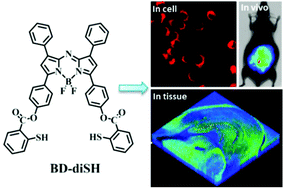A near-infrared fluorescent probe for sensitive detection and imaging of sulfane sulfur in living cells and in vivo†
Abstract
Sulfane sulfur refers to ionized sulfur that is reversibly attached to other sulfur atoms in the form of 6-valence electrons (S0). Sulfane sulfur possesses stronger nucleophilicity and reducibility than hydrogen sulfide in a series of physiological reactions, which probably makes sulfane sulfur the actual signal molecule in cells. Herein, we designed and synthesized a near-infrared (NIR) fluorescent probe BD-diSH for sensitive detection and imaging of sulfane sulfur in living cells and in vivo. The probe BD-diSH is composed of two moieties: the fluorophore azo-BODIPY and the sulfane sulfur recognition unit, viz., 2-mercapto benzoate. BD-diSH displayed high sensitivity and selectivity towards sulfane sulfur. The mercapto group (–SH) of 2-mercapto benzoic acid can nucleophilically capture the sulfur atom of thiosulfoxide tautomers in sulfane sulfur to form –SSH. The group –SSH will immediately induce intramolecular cyclization reaction and release the azo-BODIPY fluorophore to emit NIR fluorescence. The probe BD-diSH was successfully applied to detect and image sulfane sulfur in the cytoplasm of the living cells. The results illustrated that the endogenous and exogenous sulfane sulfur level changed depending on different cell lines. BD-diSH was also capable of imaging the level changes of sulfane sulfur in mice. The above applications make our new probe a potential chemical tool for the study of physiological and pathological functions of sulfur sulfide in living cells and in vivo.



 Please wait while we load your content...
Please wait while we load your content...